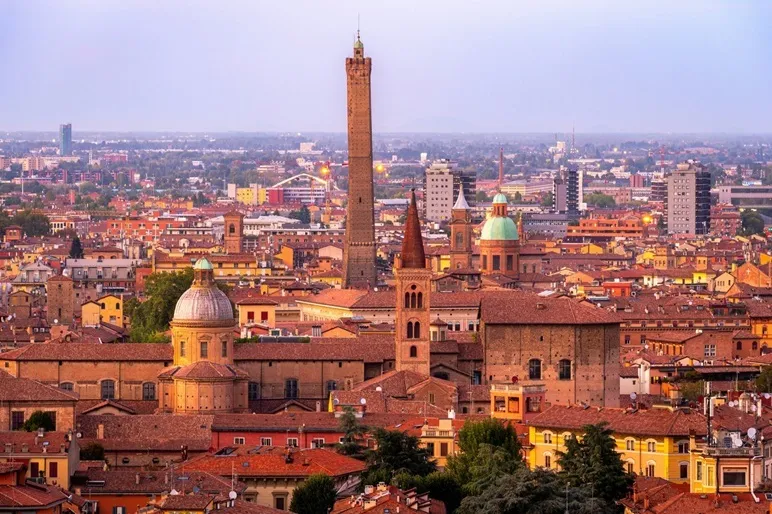Italian cuisine is much more than just pizza and pasta; it’s a journey of unexpected flavors. Join me in Bologna, the city nicknamed “La Grassa” (The Fat One) of Italy, where food is an art and life is a feast!
Bologna is not just a city, but an experience. Here, you’ll wander through ancient streets, immerse yourself in a rich cultural atmosphere, and above all, satisfy your taste buds with renowned dishes. Let’s explore Bologna, the culinary gem of Italy!
Discovering Bologna
Bologna, the capital of the Emilia-Romagna region, is a captivating city with a long history and rich culture. It is famous for its distinctive medieval architecture, charming portico-lined streets, and especially, its exceptional cuisine. Bologna is also affectionately known by the nicknames “La Grassa” (The Fat One), “La Rossa” (The Red One), and “La Dotta” (The Learned One), reflecting its culinary abundance, the red-brick buildings, and its prestigious educational heritage.

Must-Visit Attractions
Bologna offers countless fascinating sights. Here are some suggestions for a fulfilling trip:
- Piazza Maggiore: The heart of Bologna, home to important buildings such as the Basilica di San Petronio, Palazzo d’Accursio, and Palazzo del Podestà. Start your exploration here to feel the city’s vibrant rhythm.
- Basilica di San Petronio: The largest church in Bologna, notable for its imposing Gothic architecture and unfinished facade. Inside, you’ll find a giant sundial, a masterpiece of classical science.
- The Two Towers (Le Due Torri): Bologna’s iconic symbol, the leaning towers of Garisenda and Asinelli stand tall in the city center. Climb the Asinelli Tower for panoramic views of Bologna from above.
- Palazzo d’Accursio: Formerly the most important government building in Bologna, now an art and history museum. It displays artworks from the Middle Ages to the Renaissance, helping you understand the city’s development.
- University of Bologna (Università di Bologna): Founded in 1088, it is the oldest university in Europe, a source of pride for Bologna. The campus with its ancient architecture attracts many visitors interested in education and history.
- Quadrilatero District: This ancient market area is Bologna’s food paradise, where you can shop for fresh produce, cheeses, cured meats, and enjoy local specialties like pasta and mortadella.
- Basilica di Santo Stefano: Also known as “Seven Churches,” this is a complex of medieval churches, each with unique architecture and history.
- Archiginnasio Library: Formerly the main building of the University of Bologna, now a library and museum. It houses the Teatro Anatomico, a 17th-century wooden anatomical theater used for medical studies.
- Museo Civico Archeologico di Bologna: The museum displays artifacts from prehistoric times, the Etruscan and Roman civilizations, especially a rich collection of ancient Egyptian artifacts.
- Porticoes of Bologna (Portici di Bologna): Characteristic arched walkways stretching for dozens of kilometers throughout the city. The porticoes are not only a unique architectural feature but also an ideal place to stroll and explore Bologna in any weather.
- San Luca Hill and Sanctuary of the Madonna di San Luca: Located on a hill overlooking Bologna, the Sanctuary of San Luca is an important pilgrimage site. You can walk up the hill through a corridor of over 600 arches, the longest covered walkway in the world.
- Basilica of San Domenico: One of the most important churches in Bologna, housing the remains of Saint Dominic. Inside the church are sculptures by Michelangelo.
- Museum of Modern Art (MAMbo): Exhibiting international and Italian contemporary artworks, MAMbo is a prominent cultural venue for modern art enthusiasts.
Indulge in Bologna’s Cuisine
Visiting Bologna without enjoying its cuisine is like not visiting at all! This city is a culinary paradise with countless delicious and distinctive dishes.
- Tagliatelle al Ragù: Flat egg noodles with a famous minced beef sauce, often called “Bolognese” abroad. However, the correct name in Bologna is “ragù.”

- Tortellini in Brodo: Small ring-shaped pasta filled with meat, usually served in chicken or beef broth.
- Mortadella: Bologna’s famous cured meat, with a distinctive and delicious flavor.
- Lasagne Verde: Lasagna with green pasta layers made from spinach, ragù, béchamel sauce, and Parmigiano-Reggiano cheese.
- Crescentine: Fried dough pastries, often eaten with cured meats, cheeses, and sauces.
- Gelato: World-famous Italian ice cream with many delicious flavors. Don’t miss the opportunity to enjoy gelato at one of Bologna’s best gelaterias.
Travel Tips for Visiting Bologna
- Ideal Time to Visit: Spring (April-June) and autumn (September-October) are the best times to visit Bologna, when the weather is pleasant and there are fewer tourists.
- Getting Around: Bologna has a good public transport system, including buses and trams. You can also rent a bike to explore the city.
- Accommodation: Bologna offers many accommodation options, from luxury hotels to budget-friendly guesthouses. Booking in advance is recommended, especially during peak season.
- Language: Italian is the official language. However, many locals can speak English, especially in tourist areas.
- Currency: The currency is Euro (EUR). You can exchange money at the airport, banks, or currency exchange offices.
Conclusion
Bologna is a wonderful city with countless exciting things to discover. From historical architectural landmarks to a rich culinary scene, Bologna is sure to offer you an unforgettable experience. Come and feel the charm of “La Grassa,” the culinary gem of Italy!
Get ready for a culinary and cultural adventure in Bologna, where every corner holds fascinating stories and unique flavors!